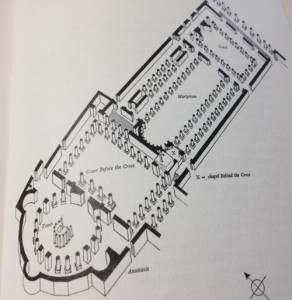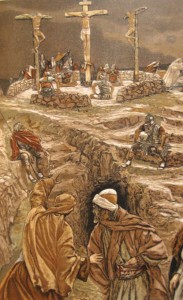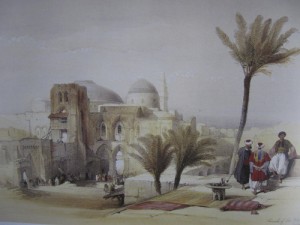The Finding of the Cross
When Constantine in the 4th century looked for Calvary and Jesus’ tomb, he had no difficulty finding their location. They were buried beneath a Roman temple built in 138 AD by the Emperor Hadrian, in the new Roman city, Aelia Capitolina, which he erected over the ruins of devastated Jewish Jerusalem. Christians since the time of Jesus knew the place and could point it out to Constantine’s builders.
Early witnesses report that, while tearing down the Roman temple and digging the foundations for the new church, the emperor’s workmen came upon an ancient cistern filled with debris from the old Roman execution site on Calvary, including three upright beams and the title that Pontius Pilate had attached to the Cross of Jesus. The discovery caused a sensation in the Christian world.
Constantine’s 80 year old mother, Helena, had come to the Holy Land as a devout pilgrim, “old in years, but young in spirit. She wanted to know this land… and walk in the footsteps of the Savior….”(Eusebius)
She took the precious remains from Calvary and distributed them, one part to the new church on Golgotha, another part to her son, Constantine, in Constantinople; the rest she placed in the chapel of her private residence at the Sessorian Palace in Rome, where they remain till this day, in the Church of the Holy Cross. She covered the floor of her Roman chapel with soil from the Jerusalem excavations.
Christians rejoiced at the discovery. Less than 25 years before, they had experienced the worst of all persecutions under the Emperor Diocletian, who tortured and killed great numbers of Christians, confiscating their homes and property. Their religion was on the verge of extermination. Now a new day had dawned; Christianity was triumphant.
The pieces of scarred wood buried in the earth for so long, reflected God’s triumphant power. They were reverently placed in settings of gold and precious stones; they were signs that, like Jesus, the church also had tasted death but was now raised up.
Besides wood from Calvary, Constantine’s builders made another great discovery as they dug the foundations for the new basilica. They discovered the tomb of Jesus, and immediately constructed a splendid rotunda around it. The tomb survives today in the Church of the Holy Sepulcher in Jerusalem’s Old City. Nearby one can still see and touch the rock of Calvary.
These early discoveries inspired a powerful movement of Christian devotion. Crowds of pilgrims made their way to the holy places. “The whole world is making its way to an empty tomb,” St. John Chrysostom said. Pilgrims returned home with reminders of their visit: small vials of oil from lamps at the tomb of Jesus, small handfuls of soil. Some even carried back tiny precious portions of the Cross itself.
A feast celebrating the dedication of this church in 325 AD is found today in various church calendars for September 14.


